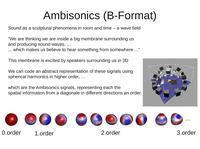Auditory Virtual Environment (AVE) for the sound-dome
The main aim to construct a AVE for the dome is derivated from the concept of the work "Kleine Welten". In the following the idea of Virtual Environments, especially Auditory Virtual Environments are discussed.
Virtual Environments (VE)
A virtual environment aims at creating situations in which humans have perceptions, that do not correspond to their physical environment, but to a virtual one. [Blauert05]
Here virtual environments are are in a way that visitors interaction with these are reduced to their control of the reception moving in these soundscapes.
Auditory Virtual Environments (AVE)
An AVE is a VE that focuses on the auditory domain only. It sees itself independent from other modalities like vision and tactility. [Blauert05]
(Nevertheless an AVE could also be combined with visual and a haptic domains. Depending on the application, the user may be only a passive receiver or even be able to interact with the environment.)
There are mainly three different approaches for implementations of AVEs [Novo05]:
- Authentic reproduction of real existing environments
- The virtual room should evoke in the listener the same percepts that would have been evoked by the corresponding real environment. He/She should have same spatial impression moving through and perceive his/her own movement inside the environment as well as the movements of sound sources.
- Reproduction of plausible auditory events
- This approach tries to evoke auditory events which the listener perceives as having occurred in a real environment. Here only those features are implemented which are needed for a specific simulation situation.
- Creation of non-authentic and non-plausible auditory events or environments
- The virtual room doesn't evoke percepts in the listener which are related to a real acoustic environment.
Auditory Visual Virtual Environments (AVVE)
As a further step the visual was introduced in the VEs, realized in the Medienkunstlabor 2009 using an panoramic screen. This developments needs clean surroundings for projections and is not applicable at the moment of this writing on an autonomous non controlled space, within the financial restrictions. Anyway since the visual perception of the dome is a sculptural work of the artist Reserl and Richard Frankenberger, we concentrate on the auditory overlay to this extraordinary experience.
Soundfield Reproduction
To reproduce soundfields, some technologies has been developed, where the most prominent are wavefield synthesis (WFS), vector based audio panning (VBAP) and Ambisonics.
WFS has mostly implementation of 2D soundfields and needs a high number of loudspeaker (200+) and is therfore more expensive than the others. Therefore it is not applicable in an low cost, low power AVE and cannot use any soundfield recording, without scene data to reproduce audio environment and therefore is mostly used in the synthesis of AVEs.
VBAP uses always the neighboring speakers to a sound direction, needs, more power on the single speakers, since less are used in parallel and like WFS, panning data for positioning virtual sources also has be produced. It has not an native abstract layer for soundfield representation.
Ambisonics is a series of techniques to record and replay a sound field. By means of encoding and decoding sound information on a number of channels, a 2- or 3-dimensional sound field can be presented. Ambisonic was mainly developed by Michael Gerzon and Peter Fellgett in the early 1970s.
In contrast to more common playback systems such as stereo or Dolby surround, Ambisonics tries to resynthesize the represented sound field mathematically correct. Therefore sounds arriving from all directions are treated equally. All speakers are generally used to localize a sound in any directions. As a result the number of needed speakers is flexible. This portability of the format makes it easy to adapt an ambisonics-encoded signal to different loudspeaker settings. The elevation level can be decoded for any loudspeaker position. Thus a three-dimensional sound field is already presented with four loudspeaker channels. Conventional formats, even with 6 channels like 5.1, are used to produce only a two dimensional sound field.
Appendix
Some Cites and Sites
- Dave Malham 1995:
- "Ambisonics is a method of recording information about a soundfield and reproducing it over some form of loudspeaker array so as to produce the illusion of hearing a true three dimensional sound image. I deliberately say illusion to stress the fact that if you truly wished to reproduce the soundfield present in a two metre sphere up to say 20 kHz then from information theory it is possible to show that you would need several hundred thousand channels and loudspeakers. All that it is practical to do is to determine how much information we can capture with some sensible combination of microphones and then to find some way of using that information to fool the ear into hearing a full soundfield." [Malham95]
- Ambisonics community, mainly 2D
- ambisonic.net
- Ambisonics Exchange at IEM
- ambisonics.iem.at
(Ambisonics spheres pictures are produced by Franz Zotter, Speaker arrangement by J.Znölnig)
| [Blauert05] | (1, 2) 'Communications Acoustics', pp 2-, Berlin 2005 |
| [Malham95] | '3-D Sound Spatialization using Ambisonic Techniques' Computer Music Journal, 19;4, pp 58-70, Winter 1995 (with Myatt, A.) |
| [Novo05] | Pedro Novo. Auditory Virtual Environments. In Communication Acoustics, Jens Blauert, Berlin 2005, p. 277-292. |

